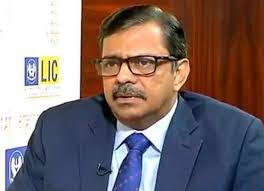 31-10-2019
31-10-2019
LIC chief on investing, growth, ULIPs, IDBI Bank merger & more

 Insurance Alertss
Insurance AlertssLIC chief on investing, growth, ULIPs, IDBI Bank merger & more

We have made a profit of about Rs 13,000 crore on equity investments of Rs 33,000 crore so far this year, says MR Kumar, Chairman, LIC. Excerpts from an interview with Nikunj Dalmia of ETNOW.
There has been a slowdown in the economy, but the insurance business is doing well. What is your view?
Yes, there is a slowdown no doubt about it but the insurance business is growing because whenever there is a downturn, people feel the need to go to safer assets. Life Insurance has always done well when there is a slowdown. But then this slowdown is not permanent. We have seen slowdowns in the past too. It is only a question of time before we get out of it, but meanwhile we are doing very well.
When we started the financial year, I am sure you must be working with some numbers and assumptions. The insurance industry is showing double digit growth. LIC is growing about 9 to 10%. Have you gone below your historical growth this year?
No, in fact, we are ahead of our historical growth rate for the last four-five years. We are growing at almost 23% in total first year premium, most of which has been driven by the sale of annuities where we are growing at almost 40%. Yes, there is a concern over the growth in numbers and that is something we want to set right now.
Your market share is north of 40%. In fact, your market share on an aggregate basis, has only gone higher and some would argue that this is the only large sector where despite being a government company, you have managed to protect your market share. What is the secret sauce here?
Let me just correct you. In first year premium this year, our market share is almost 72%. On the non-single segment, it is close to 40% as you said but I would give full credit to our agents -- 11 lakh field force, our development officers, our branch managers and entire team at LIC who have been working very hard to make this happen. You are right, this is the only country where after the opening up of the insurance sector, a government company has managed to not only hold on but got back some of the market share in recent years.
terms of the comparison with the private sector and other insurance companies. We are doing better than them and I would say that the weak point is on the 13th month persistency, which we are working on now.
LIC is in the business of protection but you are also a large investor in Indian equities, bond market and other large government dominated instruments. What has been your investment in debt and equities this year?
The NCD part of corporate debt is around Rs 40,000 crore, GSecs Rs 1,87,000 crore, equities Rs 33,000 crore, and we have made a profit on equity of about Rs 13,000 crore so far, this year.
LIC always follows the philosophy of buy the bad news. They are the last resort. When markets go down, LIC buys. When markets go up, LIC always has been selling. What has been the trend with your equity investments this year? Are you a buyer or a seller in the market?
We have done both. We have bought Rs 33,000 crore worth of equity. We have also sold around Rs 27,000-28,000 crore of equity. We have made a profit and like you said, we buy when the market is down, We are contrarians that way but then we make sure that the policyholder interest is kept at heart and that is why most of our investments are in GSecs. If you look at equity as a percentage, it would hardly be enough. In terms of volumes, it looks big but in terms of percentage, our debt and GSecs are far more.
Will that change because the yields are coming down, inflation is lower and so we will have to generate superior returns to give returns now? Would you be looking at increasing equity exposure?
We will. We will also move slowly into selling ULIP products. We find a product with the regulator and we hope to come out with it soon because that is the only way we would be able to generate returns where the regulatory issue of the restrictions on equity will not be there in a ULIP product. So, we will be able to do better there.
It’s widely believed in the market that the government has used LIC as their out-of-jail card. Every time there is a disinvestment or government issues which need a bailout, LIC has been there to bail them out. Do you review your financial decisions independently?
We do that all the time.
No government pressure ever?
We do that all the time and in fact I can tell you that wherever such investments have been made, we have made profits there also. This is something that we look at from a long term perspective. Since we are a long-term player, it does not matter what is happening in the short term.
You have large investments in some of the bluest of the blue chip companies and board seats in some. But when it comes to taking active role as a shareholder when you occupy the board seat, LIC has not been at the forefront. Is that a conscious strategy?
I would not say it is a strategy at all. Since we have a stake in a company, we need to have a nominee director on board. The nominee director keeps track of what is happening and gives us the inputs whenever required. Beyond that, we do not get into the nitty-gritties of the working of the organisations.
So, you are not involved in actively management and it will stay like this?
It will stay like that.
The environment around us is slightly mixed. The need for endowment is very large. Term is where generally there is a bit of a market share disruption and then middle of that is ULIP. Why has LIC not been able to get a large part of the ULIP market?
This is a conscious decision because we have been very strong in that area. Term, there was a complaint and I have said it earlier also that our rates are not competitive but with the product that we launched recently, Jeevan Amar and we have an online also -- Tech Term -- it is very competitive.
We believe that we will be able to grab some of that space pretty soon. As I told you ULIP also is something we are working on. In the past when we were selling ULIPs, people were more comfortable taking regular LIC policy because that is the way they have seen it all these years. We do not want to change because selling ULIPs may not necessarily mean that we are going to get a market share or we are going to grow. It will depend on what kind of returns we are able to generate for them. This year also, we have retained our bonus rate for the year. What has been working for us so far will work for us in the future as well. But I agree that we will be getting into the other areas also.
Every large sector both locally and globally have seen a massive sectoral consolidation. It has happened to airlines, hotels; it is happening in media, Within the Indian insurance sector, there are more than a dozen life insurance companies. Some of them are large and half of them do not make profit, half of them will never make profit. Would there be a massive consolidation in the private space now and that will benefit a firm like LIC?
There are 23 life insurance companies and out of that, the top 10 are doing pretty well. Maybe 13 of them have a share of 3-4% put together. But looking at the kind of potential that is available in the market, the reason why the sector was opened up in the first place, I believe there is still time for even these other companies to grow and consolidation is something that maybe will take some more time. As of now, I do not think that will happen.
We have a Life Insurance Council of insurers and they are trying to work and they have already come out with an insurance awareness campaign which probably will hit the market in November. We are repositioning life insurance as a primary financial product that people should have, before they think of other things. So I think, these companies will also grow.
IDBI BankNSE 0.15 % merger, was it a nightmarish experience?
Not really because when I came in, this had already been done. Now IDBI is a typical DFI kind of institution and we are working closely with them to find out how quickly they can get into retail space. That is the only way they are going to grow. We are on the board and we are monitoring things very carefully. We have a lot of synergy. In fact, this year, IDBI is our lead bank in terms of bancassurance business which has gone up from 2.6% to 3.6% mainly because of IDBI Bank.
They have a big ambitious target of selling insurance for us. This is one. Second, we are working to find out how we can integrate our branches with some of their branches in terms of accounts opening and things like that. Many synergies are in place already and once they get out of the PCA and start lending, they will pretty much pick up.
Do they need more money to be recapitalised?
As of now, no.
IDBI Bank is in the home loan business. LIC Housing FinanceNSE 1.94 % is also in the home loan business. As per the MOU, only one firm can do home lending. So I would assume that it would be LIC Housing Finance not IDBI Bank.
We have not taken a call on that as yet. LIC Housing has a different kind of clientele. Bank typically has a different kind of clientele. How we are going to be able to match these two is something that will take some time. Once we do that, we will take a call on whether it will be IDBI Bank or LIC HFL.
Why is that?
If you look outside of India, you will find that in most countries, it is the banks that sell insurance. It is only here that we have an insurance company upfront. If you look at the private sector also, most of them have banks. So this was something that we wanted to do for a long time. We also felt the need to have a bank, where our accounts can get integrated for a faster movement of money. Of course, we have NEFT, CIS. 20 years back, it was not there. So this has been a from 1960s and 1970s. We had strategic alliances at that time. We had strategic stake in some of the banks, but ultimately we wanted this to happen and we are happy that it has happened.
LIC Housing Finance is not the number one player, but it is a formidable player. The book is about Rs 2-2.2 lakh crore. How confident are you about your housing finance business growing at a time when others do not have the ability to lend? You have the ability to lend and also a very deep understanding of builder loans.
I believe they have come out of the kind of issues that they had. They did not have much of an issue except the inventories were too high. FM has also announced the last mile amount to be paid for finishing some of these projects. Once that happens, things will start picking up again. I am very confident LIC Housing Finance has been doing very well for us the last 15 years or so and will continue to do very well.
Do you think that loan challenges are behind the builders?
More or less, it is behind us.
While you managed to scale up your home finance business, LIC was also a big player in the mutual fund business. Some of that end of the business has not been able to scale up. Why is that?
Yes we are not very happy about the way LIC mutual fund has done so far, but then we have a new team in place now this year. For some years, there was a tie-up with Nomura and that is over now. We are very strong on the debt and liquid funds. We have not been very strong on the equity part of it, but that will change now with this new team.
How prepared are you to handle competition from private players especially in online and digital medium? I know you have a great website, but the private players are all claiming to be the best, fastest and the quickest?
True. As I said before, in our term plan, there was the issue of competitive prices which we have taken care of. Our website is very easy to navigate. We also have introduced a video medical report where people can call up the doctor over the phone and they will give advice and things can move very fast. I am confident that we will be equally fast, if not faster.
Source: The Economic Times
